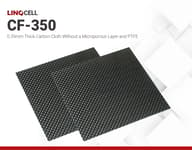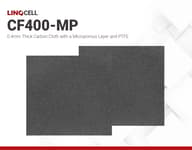Carbon cloths & Fabrics
Carbon cloths and fabrics are high-performance advanced materials made from woven or matted carbon fibers. They offer excellent mechanical strength, durability, electrical conductivity, and thermal stability, making them ideal for a variety of industrial applications. In industries such as aerospace, automotive, sports equipment, and composites manufacturing, as well as in electrical and electronic applications, carbon cloths and fabrics are widely utilized due to their exceptional properties.
The lightweight yet strong nature of carbon cloths and fabrics makes them ideal for use in structural applications. Their electrical conductivity makes them suitable for use in electrical and electronic components, while their thermal stability allows for their use in high-temperature environments. These advanced materials can be customized to meet the specific requirements of different applications, adding to their versatility and value as a material choice.
Carbon cloths and fabrics can also be treated with various resins and coatings to enhance their properties, such as improved durability and resistance to moisture and chemical exposure. In terms of sustainability, carbon fibers are a renewable resource and can be recycled, reducing their overall environmental impact.
Carbon cloth based GDLs have performance equal to that of conventional carbon papers. Carbon cloth is more practical than carbon paper because of its superior compressibility, elasticity, and flexibility performance, making it more appropriate for ongoing manufacturing and assembly processes. Carbon cloths with and without MPL can achieve the required performance and provide an alternative selection from carbon paper as GDL.
LINQCELL CF350 | 350um Carbon Fabric
- 0.35mm - 350um - 14mil
- Comes in roll form
- 5 TP Resistance
- 8 weeks
LINQCELL CF400-MP | 400um Carbon Fabric
- 0.4mm - 400um - 16mil
- Comes in roll form
- 13 TP Resistance
- 8 weeks
Product Selector Guide
| Gas Diffusion Layer Product | Type | Thickness (micron) | Basic Weight (g/m²) | Specific Surface Area (BET) (m²/g) | Benzene Adsorption (weight %) | Iodine Adsorption (mg/g) | Electrical Resistivity (ohm-cm) |
|---|---|---|---|---|---|---|---|
| LINQCELL CF350 | Fabric | 350 | 135 | 2500 | 65 | 2050 | 2 |
| LINQCELL CF400-MP | Fabric | 400 | 135 | 2500 | 65 | 2050 | 2 |
Frequently Asked Questions
What are carbon cloths and carbon fabrics?
Carbon cloths and carbon fabrics are advanced materials made from woven or matted carbon fibers. They offer exceptional strength, durability, conductivity, and thermal stability, making them ideal for a variety of applications.
They are known for their strength, durability, conductivity, and thermal stability, as well as their lightweight and versatile nature. Carbon cloths are commonly used in aerospace, automotive, sports equipment, and composites manufacturing, as well as in electrical and electronic applications.
Learn More
What are the benefits of nonwoven carbon cloths?
Non-woven carbon fabric is a type of advanced material that is made from woven or matted carbon fibers. This type of fabric offers a number of unique properties and benefits, including:
Strength and Durability: Non-woven carbon fabric is known for its exceptional strength and durability, making it ideal for use in a variety of applications where high strength and durability are required.
Conductivity: Non-woven carbon fabric is an excellent electrical conductor, making it ideal for use in electrical and electronic applications.
Lightweight: Despite its high strength, non-woven carbon fabric is also very lightweight, making it ideal for use in applications where weight is a critical factor, such as in aerospace and automotive applications.
Versatility: Non-woven carbon fabric can be easily customized to meet the specific needs of different applications, making it a versatile material for a wide range of industries.
Thermal Stability: Non-woven carbon fabric has excellent thermal stability, making it ideal for use in high-temperature applications, such as in the aerospace and defense industries.
Applications of non woven Carbon cloths
Some common applications of non-woven carbon fabric include:
Aerospace: Non-woven carbon fabric is used in the manufacture of aerospace components and structures, such as aircraft fuselages, wings, and tail sections.
Automotive: Non-woven carbon fabric is used in the manufacture of high-performance automotive components, such as brake systems and suspension parts.
Sports Equipment: Non-woven carbon fabric is used in the manufacture of high-performance sports equipment, such as golf clubs, tennis rackets, and fishing rods.
Composites: Non-woven carbon fabric is used as a reinforcement material in the manufacture of composite materials, such as fiber-reinforced plastics.
Non-woven carbon fabric is a versatile and advanced material that offers exceptional strength, durability, conductivity, and thermal stability. These properties make it ideal for use in a variety of applications, including aerospace, automotive, sports equipment, and composites.
Do you also offer Activated carbon fabric?
Not anymore, but we do have experience with the material and we are working with our research and development colleagues to bring this back to the market. We used to support the discontinued Spectracarb 2225 in the past.
High Surface Area Activated Carbon Fabric (HSAACF) is a type of advanced material that is composed of activated carbon fibers that have a high surface area. This high surface area is achieved by treating the carbon fibers with a chemical activation process, which increases their porosity and thus the overall surface area. This makes HSAACF an ideal material for a variety of applications, including air and water purification, gas adsorption, and energy storage.
Activated Carbon Fabric is a high surface-area, drapeable cloth that is used in various electrochemical devices including ultracapacitors, electrical double layer capacitors, and battery electrodes. LINQCELL ACF also serves as the high surface area electrode in many electrochemical purification and electrosorption processes, as well as unique applications such as a carrier for thin film oxides in various devices. In addition to the commercial applications of LINQCELL ACF, its use continuous to be cited in numerous research programs and articles related to energy storage, purification and electrochemical processes.
Ultracapacitor performance and energy storage is a direct function of surface area available, and LINQCELL ACF meets that objective through the open pore structure of the carbon fibers. Because of the high tensile strength of both fibers and fabric, LINQCELL ACF is also being used in the development of structural electrochemical devices.
Activated carbon fabric special features:
- Woven fabric construction /no dusting
- One-hundred percent carbon fiber with no additional binders
- High surface area suited for specialty electrochemical and chemical filtration applications
- Highly effective energy storage
- Suitable for electrosorption processes
- High drape, conformability, rollable to very small radius





